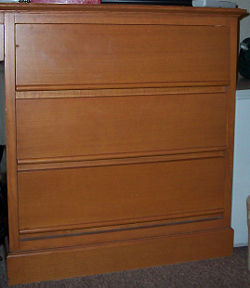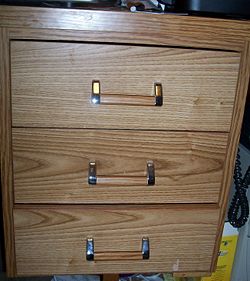Affordance: Difference between revisions
imported>Chris Day |
mNo edit summary |
||
| (One intermediate revision by one other user not shown) | |||
| Line 1: | Line 1: | ||
{{subpages}} | {{subpages}} | ||
An '''affordance''' is a feature or control which provides a signal as to how an object is supposed to be controlled or manipulated. By guiding the user to the correct operation, affordances reduce the need to explain how to use something. | An '''affordance''' is a feature or control which provides a signal as to how an object is supposed to be controlled or manipulated. By guiding the user to the correct operation, affordances reduce the need to explain how to use something. | ||
==Affordances of common controls== | ==Affordances of common controls== | ||
| Line 41: | Line 41: | ||
{{Image|AffordanceDrawerHandle.jpg|center|250px|The answer is obvious here.}}{{-}} | {{Image|AffordanceDrawerHandle.jpg|center|250px|The answer is obvious here.}}{{-}} | ||
Another common example is the door which is meant to be pushed from one side and pulled from the other, but has identical handles on either side. Often, having to provide labels for simple operations like "push" and "pull" is a sign of an affordance failure. | Another common example is the door which is meant to be pushed from one side and pulled from the other, but has identical handles on either side. Often, having to provide labels for simple operations like "push" and "pull" is a sign of an affordance failure.[[Category:Suggestion Bot Tag]] | ||
Latest revision as of 06:00, 7 July 2024
An affordance is a feature or control which provides a signal as to how an object is supposed to be controlled or manipulated. By guiding the user to the correct operation, affordances reduce the need to explain how to use something.
Affordances of common controls
Affordances suggest both operations and restrictions on those operations. For instance, the shape of something meant to be held in a hand may make it comfortable to hold only in a certain way, thus guiding the hand to the correct placement. Every type of control has an intuitive operation (in the usability sense of being commonly understood, rather than instinctively known) associated with it.
| Button (physical) | Pushing |
| Button (software) | Clicking (to do something) |
| Flat plate (as on doors) | Pushing |
| Handle | Pulling |
| Knob | Turning |
| Level | Push and pull |
| Link | Clicking (to bring up information) |
| Slider | Moving back and forth |
Lack of affordance
Where there are no affordances, even everyday objects can become confusing and difficult to use. For instance, consider a set of drawers with no handles. How do you open them? When there are handles, no one give a second thought to it.
Another common example is the door which is meant to be pushed from one side and pulled from the other, but has identical handles on either side. Often, having to provide labels for simple operations like "push" and "pull" is a sign of an affordance failure.

